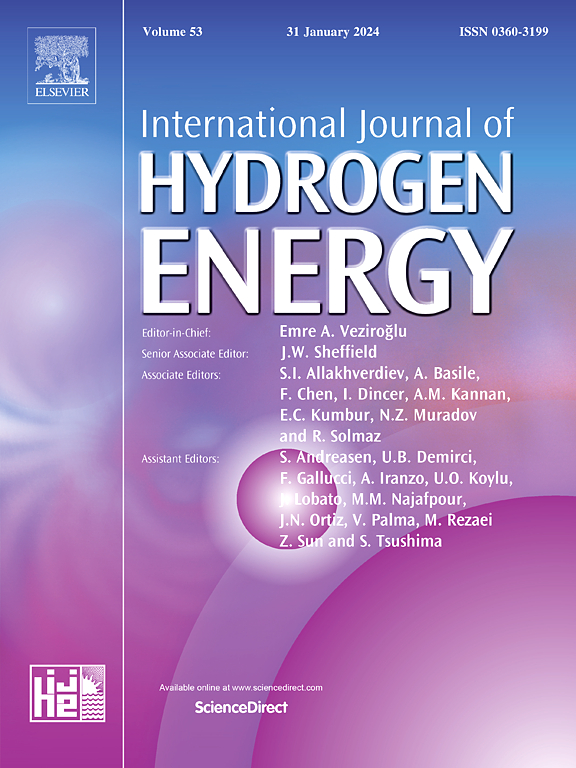电解及声电解制氢催化剂的优化
IF 8.1
2区 工程技术
Q1 CHEMISTRY, PHYSICAL
引用次数: 0
摘要
本研究探讨了ZnO、Cu2O和石墨烯催化剂在电解和声电催化中的产氢和能效优化,其中以工作功率为110W、恒定频率为40 kHz的超声浴为超声源。电解和声电解共进行了26次实验,其中电解13次,声电催化13次,每次持续5 min。研究表明声电解可提高10 - 20%的产氢率。然而,由于电流和超声波能量需求的增加,必须监测能源效率。该研究还评估了不同催化剂及其浓度对最大限度地提高氢气产量和能源效率的影响。采用实验设计法(DOE)、响应面法(RSM)和方差分析(ANOVA)对声电催化和电催化工艺进行了优化。最佳电催化条件为ZnO催化剂浓度为2.668 g/L,产氢率为57.6 cm3/h,能效为7.85%。模型的预测结果与实验结果非常吻合,证实了模型的准确性。在声电催化中,使用0.1 g/L的石墨烯导致氢气的产率为66.4 cm3/h,能源效率为2.43%,实验误差最小。这些发现突出了这些优化过程在可持续能源解决方案中实际应用的潜力。本文章由计算机程序翻译,如有差异,请以英文原文为准。

Optimization of catalyst for electrolysis and sono-electrolysis process for hydrogen production
This study explores hydrogen production and energy efficiency optimization in electrolysis and sono-electrocatalysis using ZnO, Cu2O, and graphene catalysts, where an ultrasonic bath, operating at 110W and a constant frequency of 40 kHz, was used as the ultrasound source. For electrolysis and sonoelectrolysis, a total of 26 experimental runs were conducted, including 13 runs for electrolysis and 13 for sonoelectrocatalysis, each lasting 5 min. The research indicates that sono-electrolysis can boost hydrogen production by 10–20 %. However, energy efficiency must be monitored due to the increased current and ultrasonic energy requirements. The study also evaluates the impact of different catalysts and their concentrations on maximizing hydrogen production and energy efficiency. Employing the Design of Experiments (DOE) approach, Response Surface Methodology (RSM), and Analysis of Variance (ANOVA), the study optimized both the sono-electrocatalysis and electrocatalysis processes. Optimal condition for electrocatalysis was found with a ZnO catalyst concentration of 2.668 g/L, achieving a hydrogen production rate of 57.6 cm3/h and an energy efficiency of 7.85 %. The predictions made by the model closely aligned with the experimental results, confirming the model's accuracy. In sono-electrocatalysis, the use of 0.1 g/L of graphene led to a hydrogen production rate of 66.4 cm3/h and an energy efficiency of 2.43 %, with minimal experimental errors observed. These findings highlight the potential of these optimized processes for practical applications in sustainable energy solutions.
求助全文
通过发布文献求助,成功后即可免费获取论文全文。
去求助
来源期刊

International Journal of Hydrogen Energy
工程技术-环境科学
CiteScore
13.50
自引率
25.00%
发文量
3502
审稿时长
60 days
期刊介绍:
The objective of the International Journal of Hydrogen Energy is to facilitate the exchange of new ideas, technological advancements, and research findings in the field of Hydrogen Energy among scientists and engineers worldwide. This journal showcases original research, both analytical and experimental, covering various aspects of Hydrogen Energy. These include production, storage, transmission, utilization, enabling technologies, environmental impact, economic considerations, and global perspectives on hydrogen and its carriers such as NH3, CH4, alcohols, etc.
The utilization aspect encompasses various methods such as thermochemical (combustion), photochemical, electrochemical (fuel cells), and nuclear conversion of hydrogen, hydrogen isotopes, and hydrogen carriers into thermal, mechanical, and electrical energies. The applications of these energies can be found in transportation (including aerospace), industrial, commercial, and residential sectors.
 求助内容:
求助内容: 应助结果提醒方式:
应助结果提醒方式:


